Civics - Class 10
Democratic Politics - II
Chapter 4: Gender, Religion and Caste
Intext Questions:
Question 1: Why are we discussing things like household work in this textbook on Political Science? Is this politics?
Answer:
No, this is not politics. Every woman in India is expected to do so many household chores but few of them are allowed to do jobs. That's the point of gender inequality in society. Patriarchal and Orthodox mindset still exists in India where women are not getting equal rights on par with men.
Question 2: Why not? If politics is about power, then surely male dominance in the household should be considered political.
Answer:
Many theories reflect that politics begin from home. When male dominates females, this hierarchy is followed throughout the system. Patriarchy is what suppresses women in all fields of life
If politics ends at home or women get equal rights, women will get equal chances in all spheres of life.
Question 3: Discuss all these perceptions of ideal women that prevail in our society. Do you agree with any of these? If not what is your image of an ideal woman?
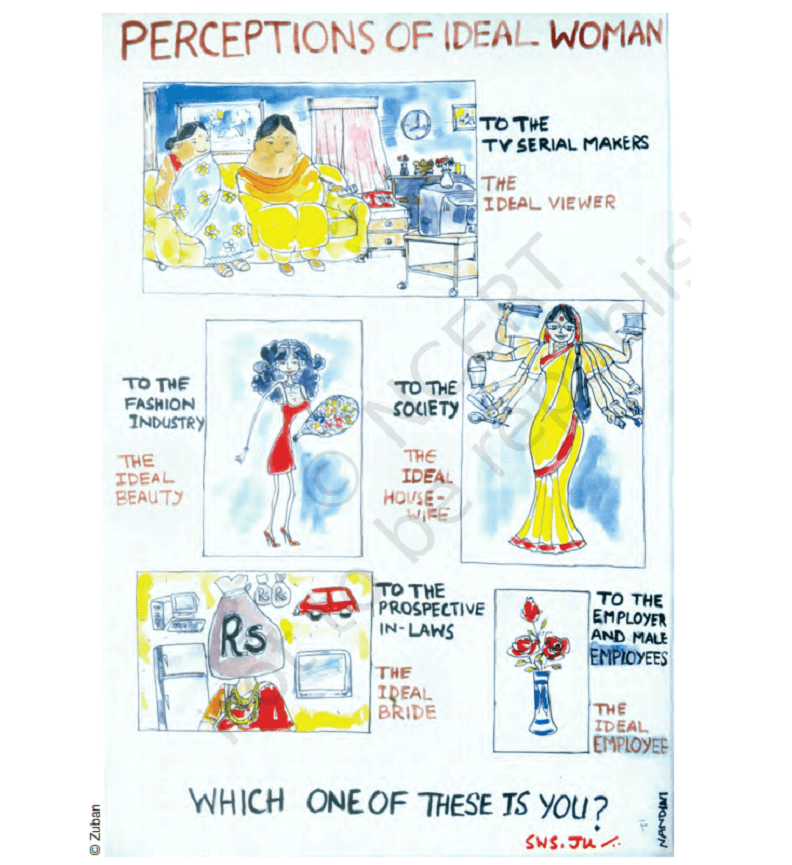
Answer:
It is not possible to agree with any one perception of women, shown through the figures. In today’s times, woman are balancing housework, work outside the house and their carriers equally.
In my view women should not be tied in the image of an ideal woman. They should have equal rights and opportunities, to be what they want to be and live a life of good health and happiness.
A ‘time use survey’ was conducted in six states of our country. It shows that an average woman works every day for a little over seven and half hours while an average man works for six and a half hours. Yet the work done by men is more visible because most of their work leads to generation of income. Women also do a lot of direct income generating work, but the bulk of their work is household related. This work remains unpaid and invisible.
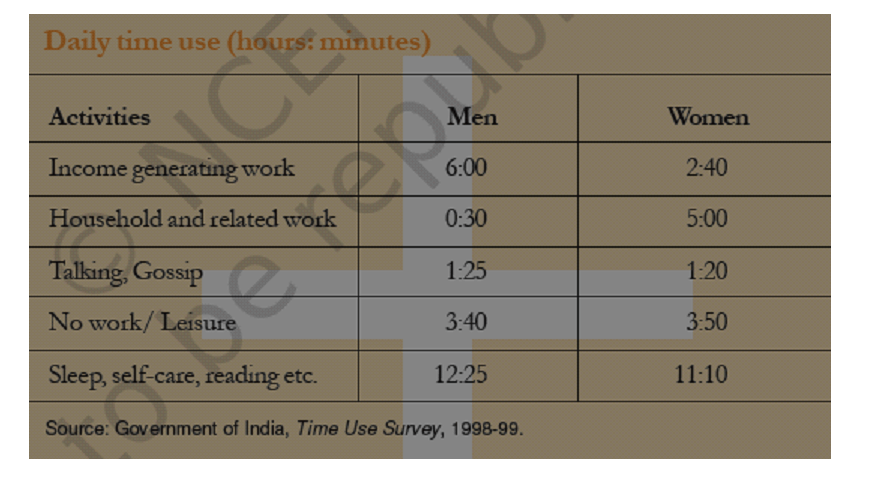
You can conduct a similar time use survey in your own household. Observe all the adult male and female members of your family for one week. Every day note down the number of hours each of them spends on the following activities: income generating activity (working at the office or shop or factory or field, etc.), household related activity (cooking, cleaning, washing, fetching water, looking after children or elders, etc.), reading and recreation, talking/gossiping, self-care, taking rest or sleeping. If necessary make new categories. Add up the time taken on each activity for a week and calculate the daily average for each activity for each member. Do women work more in your family as well?
Answer:
Survey report conducted in my household is:
FATHER :
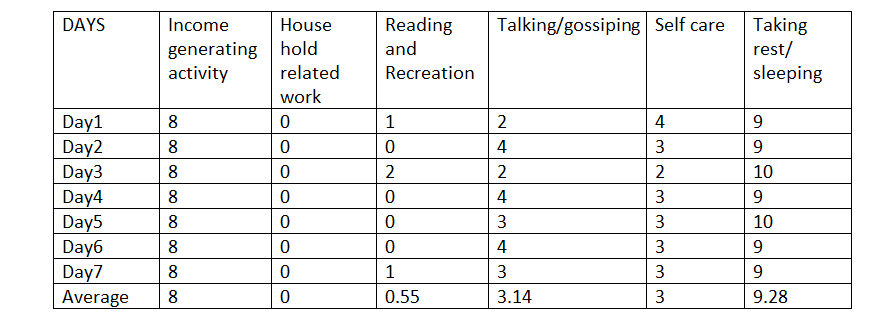
MOTHER :
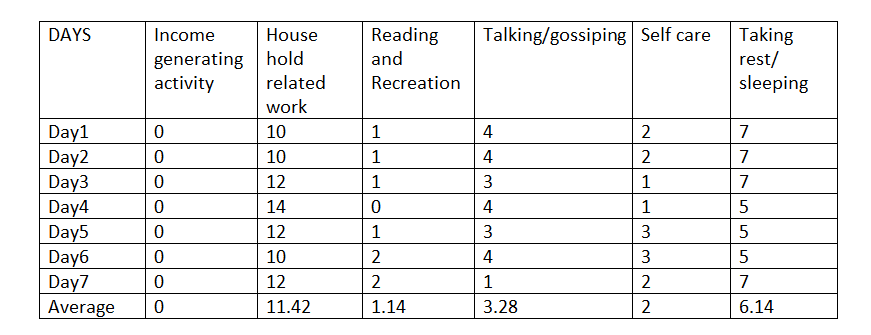
BROTHER :
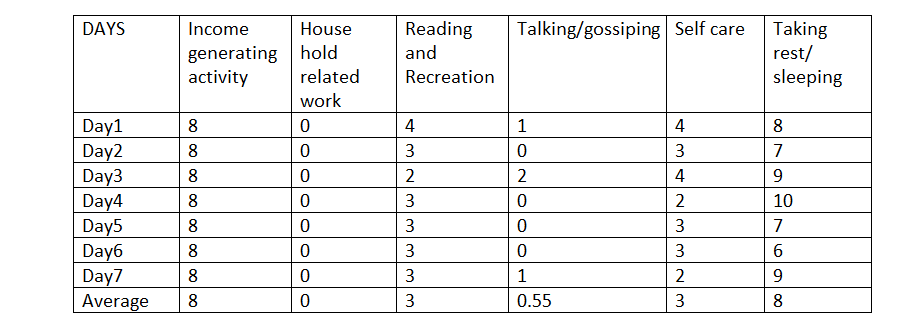
Yes, Women work more than men in every household. But their household is least recognised, as it is not an income generating work.
Question 4: Mummy always says to outsiders: “I don’t work. I am a housewife.” But I see her working non-stop all the time. If what she does is not work, what else is work?
Answer:
What she does is also work but it is considered as work in our male dominated society because it is not connected with earning of money. Most of the time men work less than women but they work is valued because they work outside and earn money. Since money is not involved in the work of house-wives, it is said that they don't work. This mind-set is very old and needs to be changed. Women's work should be given as much value as work done by them.
Question 5:
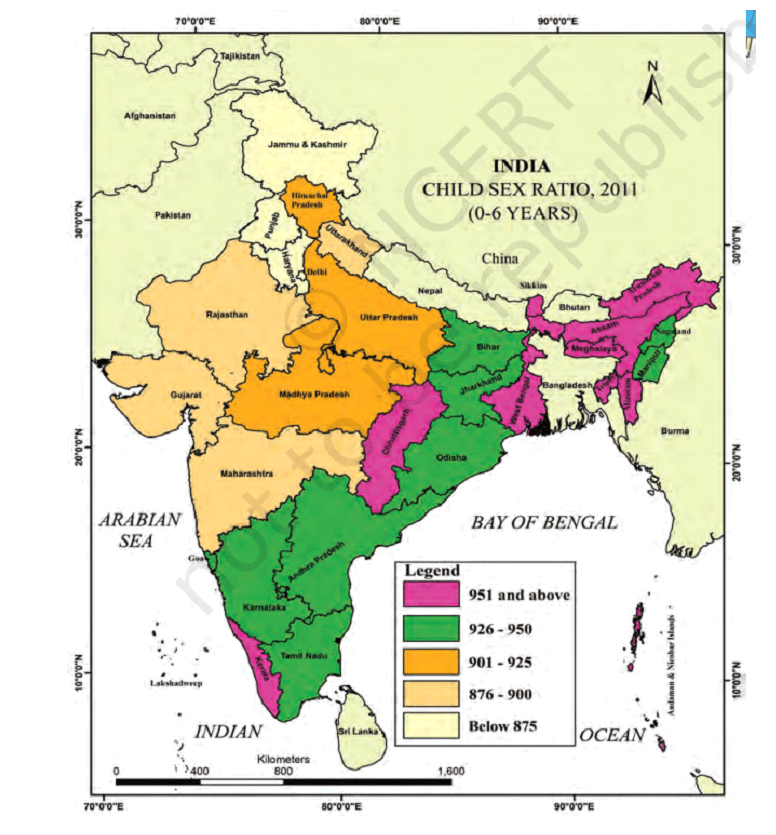
A) Can you identify your State on this map? What is the child sex ratio in it? How is it different from others with a different colour?
Answer:
My state is Andhra Pradesh. Its child sex ratio is between 945. Its range is shown in green colour.
B) Identify the States which have child sex ratio below 900 ?
Answer:
Maharastra, Gujarat, Rajasthan, Uttarakhand, Haryana, Punjab and Jammu and kashmir.
C) Compare this map with the poster on the next page. How do the two of them tell us about the same issue?
Answer:
Both the map and poster are concerned about the decreasing trend of child sex ratio
Question 6: Could you think of some reasons why women’s representation is so low in India? Do you think America’s and Europe have achieved a satisfactory level of women’s representation?
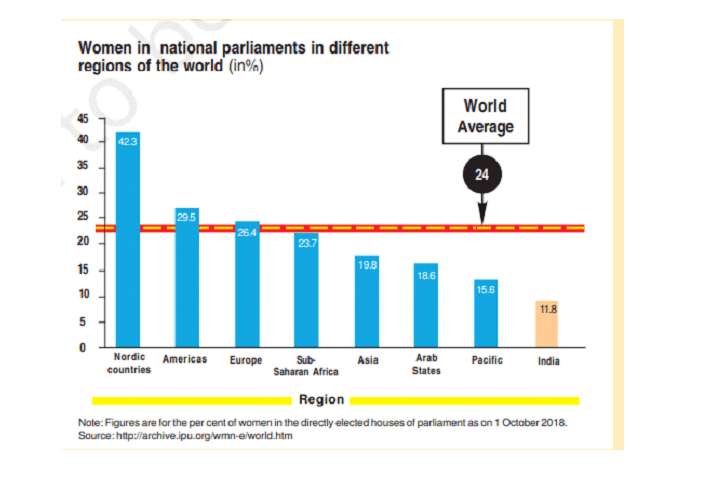
Answer:
(i) The reasons for low level of women participation in politics are:
- Women’s literacy rate is very low. Even if some are educated, they are not politically motivated.
- Society thinks that politics is not the profession of women.
- Political parties are also not giving tickets to women candidates to fight election in proportion to their population.
Question 7: If casteism and communalism are bad, what makes feminism a good thing? Why don’t we oppose all those who divide the society on any lines- caste, religion or gender?
Answer:
Feminism does not encourage division politics. It advocates women rights on the ground of the equality of the sexes. It believes in equal rights and opportunities for men and women. Social divisions like communalism and castes usually divide the society and enhance inequality while feminism talks about equality. With stronger women comes stronger society.
Question 8: This cartoon offers an understanding of why the Women’s Reservation Bill has not been passed in the Parliament. Do you agree with this reading.
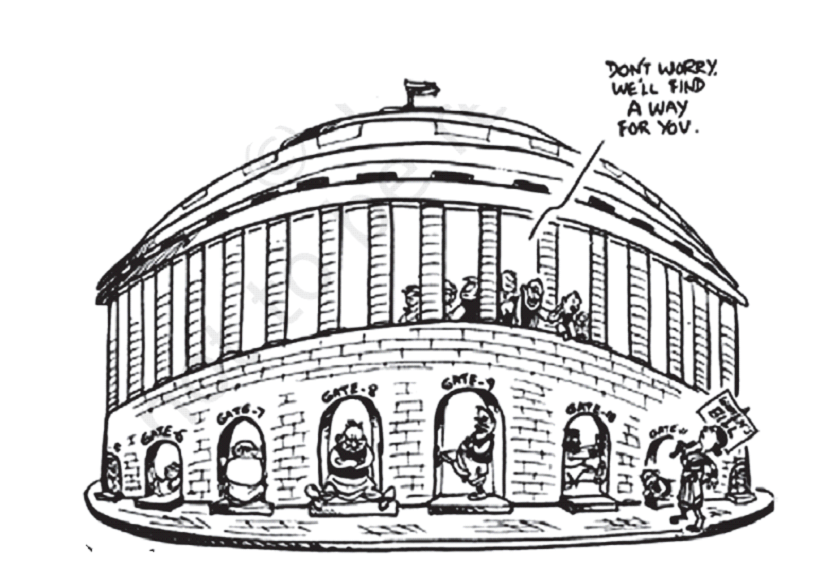
Answer:
Yes, the cartoon reflects that our legislature is male - dominated. Every gate to the parliament is well guarded by men who do not wish women to enter the house. But, they pretend to show that very soon they are going to pass a bill regarding women’s reservation in the house.
Question 9: I am not religious. Why should I bother about communalism and secularism?
Answer:
If you are not religious it means you don’t believe God. Communalism is a social phenomena based on the barbaric attitude of some religious communities. This attitudes and activities follows it harm the social system and the relations among the different religious communities.
So, you should also bother about communalism to make peace in the society.
Secularism means there is no state religion instead the state respects all religions equally. So, whether you are religious or not, you should also bother about the secularism so that there will not be any favour or discrimination against any religion. It will maintain a healthy atmosphere in the country.
Question 10: I often crack jokes about people from one religion. Does that make me communal?
Answer:
Religion is a faith of a person or a group of people in a particular way of prayer to a specific supernatural power. This faith is very much based on personal and community grounds. So, you should not make jokes about the people of any religion. It may result communal tension in the society and you will be responsible.
Question 11: I don’t care what my caste is. Why are we discussing all this in the textbook? Are we not promoting casteism by talking about caste?
Answer:
Casteism is not promoted by talking about castes in this text book. India is a religious and caste based country with multiple languages in usage. It is known fact that there are people of different castes living together in India society. So reality cannot be hidden. This is the reason why there is a discussion on caste in this textbook. The ill effects of casteism can be explained to students in this age itself for a better India.
Question 12: Now you don’t like it! Didn’t you tell me that wherever there is domination, we should discuss it in political science? Will caste disappear if we keep mum about it?
Answer:
(i) Caste is dominating Indian society and thereby it has its say in politics as well. As said in the textbook whenever there is domination, it should be discussed in the political science. So caste is discussed in political science.
(ii) Caste will not disappear from the India politics and from society merely by keeping mum about it. Because it has become a part and parcel of our political and social system.
Question 13: Do you think that political leaders are right to treat people belonging to a caste as ‘vote banks’?
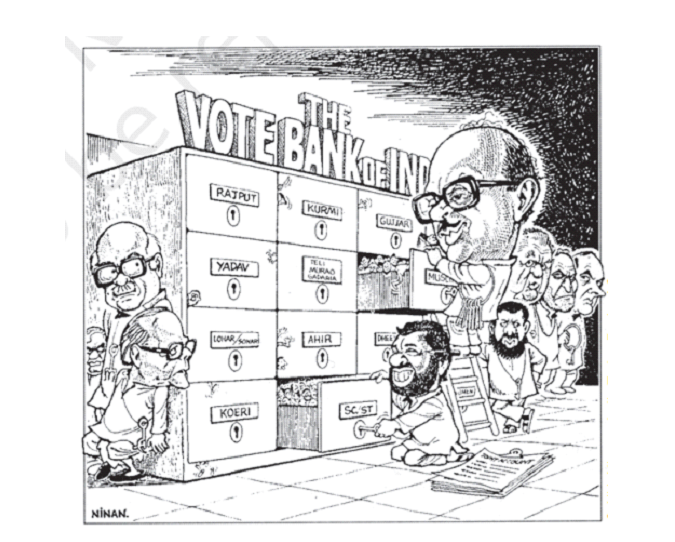
Answer:
I think that political leaders are not right in treating people belonging to a caste as vote banks. The process of dividing vote bank based on caste will divide the society into different groups by dirty game of politicians and political parties during elections to win the election. This encourages social division in the society which leads to conflicts among the people. It disturbs social harmony.
Exercises
Question 1: Mention different aspects of life in which women are discriminated or disadvantaged in India.
Answer:
Women on the basis of gender have always been discriminated in almost all the societies of the world including India. Ours is a patriarchal society. Women face disadvantage, discrimination, and oppression in various ways as mentioned below.
Education :
Women are deprived of equal access to education. Thus, the literacy rate among women is only 59.3 percent as compared to 78.8 percent among men.
A smaller proportion of girl students go for higher education because in spite of their better performance than boys, they drop out as parents prefer to spend their resources for their son’s education, they do not want to spend equally on their sons and daughters.
Discrimination in job opportunities and remuneration or salary :
Under Equal Wages Act, equal wages should be paid for equal work. In practice almost in every sphere, women are paid less than men, even when both do exactly the same work, On average an Indian woman works one hour more than an average man every day. Yet much of her work is not paid and therefore often not valued.
Preference for sons:
Even now in many parts of India, parents prefer to have sons, There are cases where a girl child is aborted before she is born. Due to sex-selective abortion, the sex-ratio has declined from 927 in 2001 to 850 or 800 in some places.
Harassment against women:
Women are being harassed by their employers at work place. They are sexually assaulted at homes. They are not safe during their journey at night. They are subjected to various forms of domestic violence such as beating and harassment.
Question 2: State different forms of communal politics with one example each.
Answer:
Communalism involve religious prejudices, stereotypes of religious communities and belief in the superiority of one’s religion over other religions.
A communal mind often leads to a quest for political dominance of one’s own religious community. Different forms of communal politics are:
- For those belonging to the majority community, this takes the form of majoritarian dominance.
- For those belonging to the minority community, it can take the form of a desire to form a separate political unit.
Question 3: State how caste inequalities are still continuing in India.
Answer:
Caste is the dominant principle in contemporary India. Caste still persists in India even though it took new forms . Even now most people marry within their own caste or tribe. Untouchability has not ended completely, despite constitutional prohibition. The legacy of upper and lower castes is still felt today in the society.
Caste continues to be closely linked to economic status:
The caste groups that had access to education under the old system have done very well in acquiring modern education as well. Those groups that did not have access to education or were prohibited from acquiring it have naturally lagged behind. That is why there is a disproportionately large presence of ‘upper caste’ among the urban middle classes in our country.
Question 4: State reasons to say that caste alone cannot determine election results in India.
Answer:
The caste alone cannot determine election results in India because of the following reasons:
-
No majority of one caste in a constituency:
No parliamentary constituency in the country has a clear majority of one single caste. So, every candidate and party needs to win the confidence of more than one caste and community to win elections. -
No votes of one caste/community:
No party wins the votes of all the voters of a caste or community. When people say that caste is a vote bank of one party, it usually means that a large proportion of the voters from that caste vote for that party. -
Candidates from the same caste :
Many political parties may put up candidates from the same caste if that caste is believed to dominate the electorate in a particular constituency. All these factors divide the voters between two or more candidates.
People within the same caste or community may have different interests depending on their economic condition. Rich and poor or men and women from the same caste often vote very differently.
Question 5: What is the status of women’s representation in India’s legislative bodies?
Answer:
In India, the percentage of elected women in legislature is merely 12 percent of its total strength where they constitute 50% of the population. Their share in the state assemblies is less than 5 percent. In this respect, India is among the bottom group of nations in the world. India is behind the averages for several developing countries of Africa like Rwanda, Somalia and Latin America where women percentage in legislature crossed 50 percent. In the government, cabinets are largely all-male even when a woman becomes the Chief Minister or the Prime Minister.
Question 6: Mention any two constitutional provisions that make India a secular state.
Answer:
Two constitutional provisions that make India a secular state are given below :
(1) India is secular state as per preamble of the constitution. There is no official religion in India. Our Constitution does not give a special status to any religion like Islam in Pakistan, Buddhism in Sri Lanka and Christianity in England. State observes an attitude of neutrality and impartiality towards all religions.
(2) Under Article 25 of the Indian Constitution, it provides to all persons and communities freedom to profess, practice and propagate any religion or not to follow any.
Question 7: When we speak of gender divisions, we usually refer to :
(a) Biological difference between men and women.
(b) Unequal roles assigned by society to men and women.
(c) Unequal child sex ratio.
(d) Absence of voting rights for women in democracies.
Answer: (b) Unequal roles assigned by society to men and women.
Question 8: In India, seats are reserved for women in
(a) Lok sabha
(b) State legislative assemblies
(c) Cabinets
(d) Panchayati Raj bodies
Answer: (d) Panchayati Raj bodies
Question 9: Consider the following statements on the meaning of communal politics: Communal politics is based on the belief that :
A. One religion is superior to that of others.
B. People belonging to different religions can live together happily as equal citizens.
C. Followers of a particular religion constitute one community.
D. State power cannot be used to establish the domination of one religious group over others.
Which of the statements is/are correct?
(a) A, B, C and D
(b) A, B and D
(c) A and C
(d) B and D
Answer: (c) A and C
Question 10: Which among the following statements about India’s Constitution is wrong?
(a) prohibits discrimination on grounds of religion.
(b) gives official status to one religion.
(c) provides to all individuals the freedom to profess any religion.
(d) ensures the equality of citizens within religious communities.
Answer: (b) gives official status to one religion.
Question 11: Social divisions based on ……………… are peculiar to India.
Answer: caste
Question 12: Match List I with List-II and select the correct answer using the codes given below the Lists:
| List-I | List-II |
|---|---|
| 1. A person who believes in equal rights and opportunities for women and men | A. Communalist |
| 2. A person who says that religion is the principal basics of community | B. Feminist |
| 3. A person who thinks that caste is the principal | C. Secularist |
| 4. A person who does not discriminate other on the basis of religious beliefs | D. Castiest |
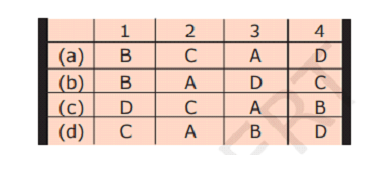
Answer: (b) B, A, D, C is the correct answer.